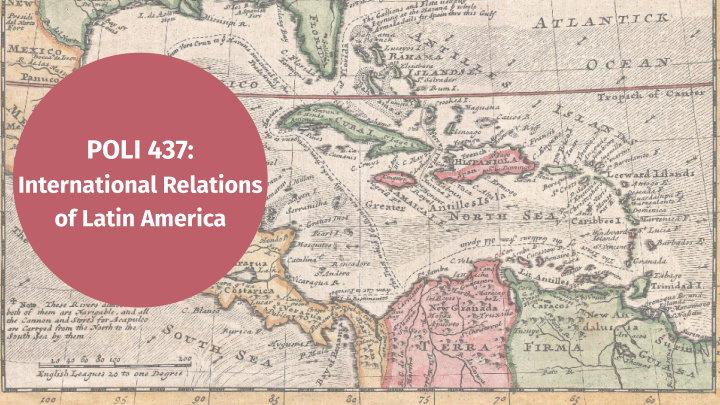



POLI 437: International Relations of Latin America
TODAY How to read articles The problem of causality Reading big tables
READING BETTER Amelia Hoover Greene on reading political science better Better = efficiently + good notes Good note-taking —> easier review
• Abstract : short. motivation of study, argument, data, results, almost the Tweet-able version • Introduction : basically an extended version of the abstract • Lit Review: Who else has written about X? What have they said? How is this different? • Theory : argument for why X causes Y, or the model • Data : Description of data sources; where does it come from? Limitations? • Results : What did they find? Does the theory/argument bear out? • Conclusions: Implications of research for future work, summary
SIGNPOSTS Research articles/books are not mystery novels Most sections appear in order! Look for signposts that point to valuable info
CAUSALITY IS HARD In social sciences we (mostly) care about one thing: “How does X affect Y”? It turns out knowing is very difficult
RATS AND INSULIN Does this new insulin drug cause cancer? 100 rats, 50 (randomly) get insulin, 50 get placebo Measure amount of cancer tissue in each
Table 1 rat drug cancer_tissue 1 1 drug -2.31 2 2 placebo -0.111 3 3 placebo 0.0751 4 4 placebo 1.17 5 5 placebo 0.934 6 6 drug -2.40 7 7 placebo 0.864 8 8 drug -2.31 9 9 drug -1.77 10 10 drug -0.845
Calculate average cancer rate in each group % of rats with cancer, insulin = 12% % of rats with cancer, placebo = 4% Sounds like this drug causes cancer (at least in rats) Note how simple this is! Just taking averages Note also no before and after
RESEARCH QUESTION: Does having kids cause people to have more affairs? Go out and survey people (Data: Psychology Today in 1969) Ask how many affairs they’ve had, if they have kids, other stuff
Table 1 a ff airs gender age children 1 0 male 22 no 2 0 male 42 yes 3 0 male 22 no 4 0 female 27 yes 5 0 male 37 yes 6 0 male 57 yes 7 0 female 22 no 8 0 female 22 no 9 7 male 42 yes 10 0 female 22 no
Avg. affairs, kids = 1.6 Avg. affairs, no kids = .9
Can we conclude that having kids causes people to have affairs? How is this different from the rat example?
THE DIFFERENCE We randomly give the rats the drug, and they don’t get to choose People choose whether to have kids or not and they choose whether to have an affair
THE PROBLEM Since people can choose , certain kinds of people might choose to have affairs and to have kids But the kids don’t cause the affairs; there’s some confounding variable messing all this up
???? Kids A ff airs
Some people in our data have been married 2 years; others 15 years How might how long a couple has been married be a confound here? Longer marriage = more likely to have kids AND more likely to have affairs
So if we’re worried about length of marriage, what could we do?
THE SOLUTION Look at the difference in average # of affairs between couples with and without kids… … comparing people who have been married the same amount of time
THE SOLUTION For people married < 5 years… Are people with kids more likely to cheat than people without kids? For people married 5-10 years… Are people with kids more likely to cheat than people without kids?
THE SOLUTION If people with kids still have more affairs, then we know it’s not because of years of marriage This is called controlling or adjusting for a confounding variable
BACK TO THE RATS Why don’t we worry about this kind of thing with the rats? Because we randomly assigned the insulin; it is therefore very unlikely that there is some lurking confound
TIP OF THE ICEBERG Controlling is just one of many approaches, but it’s the most common
SCANDALS
THE BIG REGRESSION TABLES Researchers are trying to control for all sorts of confounds Here: effect of scandals —> prez approval
INTERPRETING TABLES The numbers next to the variables are called coefficients They describe the relationship between X and Y, controlling for the other vars.
TEMPLATE “A one-unit increase in X is associated with a ___ in increase/decrease in Y”
Scandal = “presidents who suffer scandals have .7 less points of approval on average than those without scandal” Unemployment: “an increase in unemployment of 1% is associated with a decrease of 1.02 app points”
INTERPRETATION Scandal vs. no scandal… An increase in unemployment… Different wording, why?
Continuous : Price ($), income, age, height, unemployment Discrete: Republican/Democrat, in the south/not in south (states), scandal/no scandal
“for every additional dollar of income there is an increase in prez approval rating of 10 points” “Compared to women, men are 4% less likely to vote”
WHAT ABOUT THE STARS? You should be more confident in the results the more data you have and the stronger the effect
The stars quantify this confidence Basically, at least one star = we’re confident result is statistically significant *** p < 0.001, ** p < 0.01, * p < 0.05
BACK TO CONTROLS Used to see if a result persists even after controlling for confounds In this example, there is no statistically significant relationship between scandals and presidential approval, controlling for these other factors
Class for today has an activity
NEXT WEEK Impossible summary of LA history
Recommend
More recommend